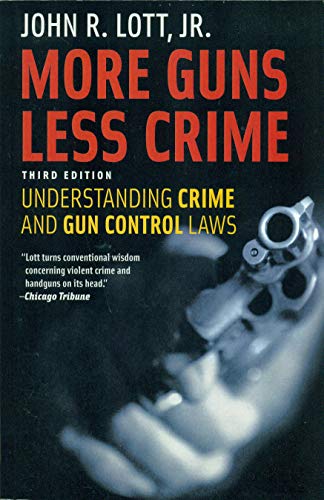“More Guns, Less Crime” is a book written by John R. Lott, Jr. published in 1998. The book highlights a comprehensive study on the impact of firearm ownership in society. Lott’s research is grounded in data which he gathered from all 3,054 US counties between 1977 and 1992.
The book aims to prove that areas where firearm ownership is allowed and encouraged experience lower crime rates. In this blog, we will delve into the top ten lessons found in Lott’s book.
“Indeed, if one considers all the people who have died as a result of gun violence in the twentieth century, all the tyrannies that have been established, all the populations that have been exterminated, all the wars that have been waged, one can only conclude that the cost of gun control is far higher than the cost of gun ownership”
Lesson 1: The more guns in a region, the lesser the crime rate
Lott argues that more guns equate to lesser crime rates because criminals actively avoid areas where they are likely to encounter armed individuals. Additionally, gun ownership offers self-defence and protection from criminal activities. Therefore, criminals are less likely to initiate deadly confrontations when they are uncertain if their adversary is armed.
Lesson 2: Gun ownership increases the chances of the criminal being injured
“Incremental capital and operational investments in home defense costs”, or simply “ICOH”, refers to the costs of securing and protecting one’s home or business. Lott’s findings show that the more the ICOH, the less likely the victim is injured by the criminal. Therefore, armed defence against crime is an effective method for reducing injuries from criminal activities.
Lesson 3: Gun ownership reduces injuries and deaths from terrorist attacks
Lott argues that gun ownership plays an essential role in preventing mass shootings and terrorist attacks. Gun owners are typically on high alert and vigilant, which allows them to notice any suspicious activities and possibly deter the attackers before they cause damages. Moreover, armed individuals can put up a defensive barrier, halt the progression of the attacker, and save sprees of injured individuals.
Lesson 4: Laws that restrict gun ownership results in a higher incidence of crimes
Lott states that areas where gun ownership is restricted invariably experience higher crime rates. The argument is that gun restrictions only make it more challenging for the citizens to protect themselves, giving the criminals a more significant advantage.
Lesson 5: Gun ownership helps women protect themselves
Women, in general, are physically weaker than men, making them more vulnerable to physical assaults. Lott argues that gun ownership serves as the equalizer between men and women. Women who own guns are more empowered to protect themselves from sexual assault or domestic abuse.
Lesson 6: Gun-free zones do not improve the safety of the people within the zone
Lott asserts that gun-free zones attract criminals who know the people within the zone will be unarmed. A prime example is the number of mass shootings that have occurred in gun-free zones.
Lesson 7: Concealed carry laws do not lead to more crimes being committed
Critics of concealed carry laws claim that more guns would lead to more violent crimes. However, Lott points out that states that implemented concealed carry laws did not experience an uptick in violent crime rates. Instead, they experienced more minor incidence of crimes or no change at all.
Lesson 8: Gun ownership results in a more significant reduction in property crimes
According to Lott, areas where gun ownership is high also experienced lesser property crimes or burglaries. This belief is because the citizens are effectively equipped to deter criminal activities, including both violent and non-violent crimes.
Lesson 9: States with higher concealed carry permit holders have fewer homicides
Many critics of concealed carry permits argue that carrying guns even for self-defence would lead to more homicides. However, Lott points out that states with higher numbers of concealed carry permits also experienced fewer homicides per person.
Lesson 10: Gun ownership increases social trust and bonds
Lastly, according to Lott, gun ownership results in increased social trust and an improved sense of community. A community where several members own firearms is more united, responsible, and accountable than others.
Conclusion
In conclusion, John Lott Jr.’s “More Guns, Less Crime” provides a compelling case for the positive effects of firearm ownership. Lott’s findings suggest that firearm ownership serves as an effective deterrent that significantly reduces crime rates. The lessons we have learned above reinforce that firearm ownership is a crucial element in protecting individuals and their property while fostering peace within the community.



